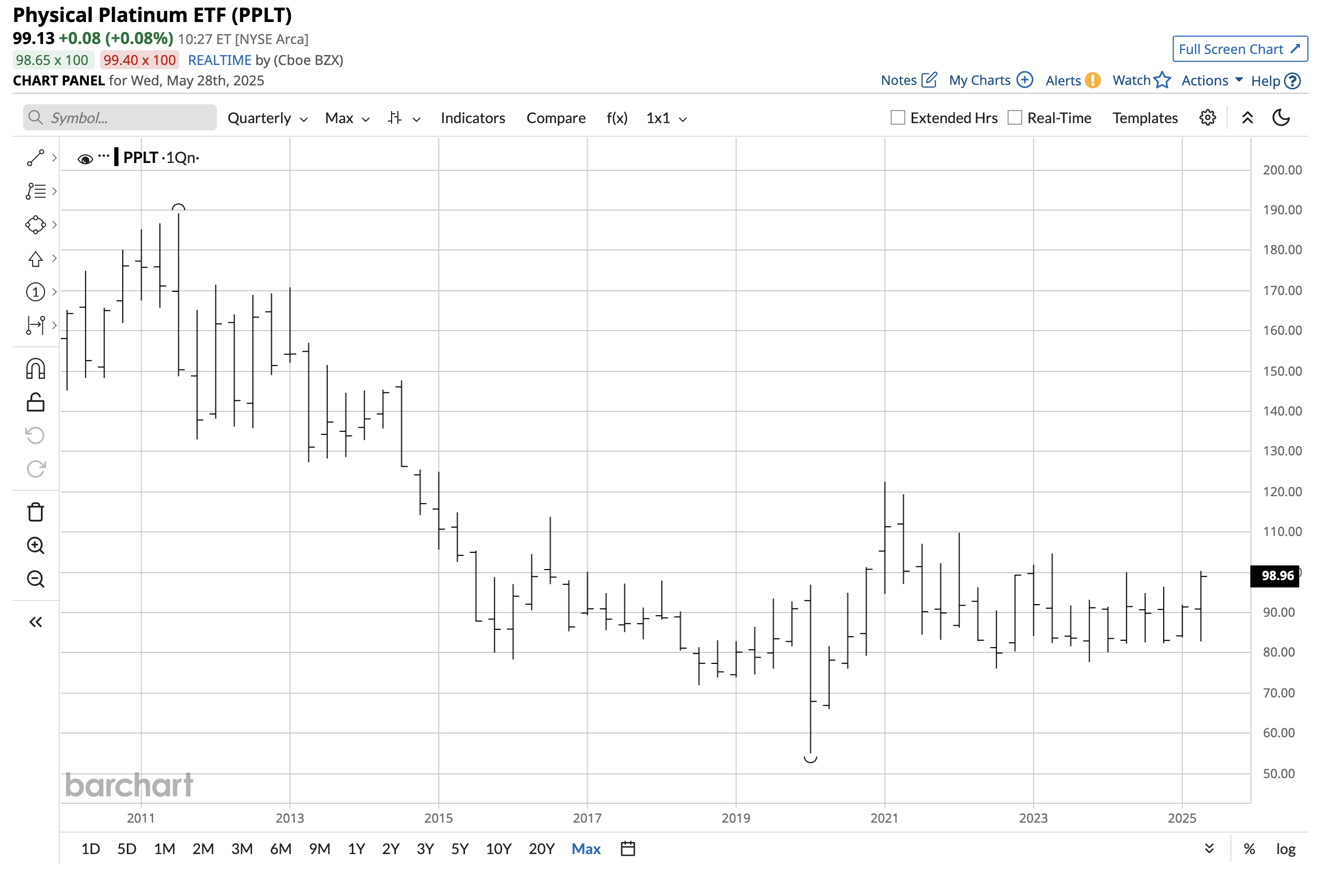|
||
|
Name
Cash Bids
Market Data
News
Ag Commentary
Weather
Resources
|
Will Platinum’s Price Ever Move Higher?
In my April 8, 2025, Barchart article on precious metals in Q1 2025 and beyond, I concluded: Platinum and palladium prices remain inexpensive compared to gold and silver at below the $1,000 per ounce levels. While platinum and palladium closed Q1 above the $1,000 pivot points, they failed again. While gold and silver could correct appreciably based on technical support levels, the platinum group metals could have less downside potential because of the current low levels compared to their precious cousins. NYMEX platinum futures settled at $1,009.70 on March 31, 2025, and were higher in late May 2025 but the consolidation around the $1,000 level continues. Range trading for a decadeWhile nearby NYMEX platinum futures have traded as low as $562.00 and as high as $1,348.20 over the past decade, most of the metal’s price action has been around the $1,000 per ounce pivot point.  The monthly NYMEX platinum futures chart highlights that when platinum falls below $1,000, buying emerges to lift the price, and when it rises above the $1,000 level, selling sends it back to and below the pivot point. Platinum does not reflect the price action in gold and silverWhile platinum has made a higher low since the 2020 pandemic-inspired $562 bottom, the NYMEX futures have made lower highs since the 2021 $1,348.20 high in a consolidation pattern. While platinum prices have gone nowhere in the past years, gold and silver prices are in bullish trends.  The ten-year COMEX gold futures chart highlights gold’s pattern of higher lows and higher highs, leading to new record highs in 2011, 2020, 2023, 2024, and 2025.  The ten-year COMEX silver futures chart illustrates silver’s new multi-year highs in 2020, 2021, 2024, and 2025. While gold and silver prices have been in bullish trends, platinum’s price continues to consolidate around the $1,000 level. Investors and traders have remained on the sidelinesThe upward price momentum in the gold and silver markets has attracted many investors and traders to buy the precious metals, as trends are always their best friends. Platinum’s lack of any sustained bullish or bearish path of least resistance has caused them to ignore the metal despite its membership in the precious metals sector. While platinum offers historical value versus gold and silver, the price action has not supported the metal, leaving it drifting in a consolidation range around the $1,000 per ounce pivot point. Platinum is a precious and an industrial metalPlatinum is a rare metal, and most production comes from South Africa and Russia. In Russia, platinum output is a byproduct of nickel production. Each year, platinum production is far lower than gold and silver on a per-ounce basis, and global platinum stockpiles are far lower. In the futures market, platinum open interest, the total number of open long and short positions, is much lower than gold and silver, and the daily volumes are also lower than those of its precious cousins.  The quarterly NYMEX platinum futures chart illustrates that the bullish trend in platinum futures ended at the high of $2,308.80 in Q1 2008. Since then, platinum futures have made lower highs and moved into a consolidation trend around the $1,000 pivot point over the past decade. PPLT is a platinum ETF that owns physical platinum bullionThe fund summary for the Aberdeen Physical Platinum ETF product (PPLT) states:  At $99.13 per share, PPLT had over $1.172 billion in assets under management. PPLT trades an average of 234,311 shares daily and charges a 0.60% management fee  The quarterly chart illustrates that PPLT has traded between $90 and $100 per share since 2015, following platinum futures prices. The price action in gold and silver, platinum’s position as an industrial and precious metal, and its liquidity could eventually cause the metal to break out of its consolidation range. Like a rubber band stretched for long periods, an eventual snap could send platinum prices substantially higher if gold and silver are precious guides. Platinum could have limited downside potential and an explosive upside if the long-term consolidation gives way to a sustainable trend. Buying PPLT or platinum on price weakness has been optimal for years, and I expect that trend to continue. On the date of publication, Andrew Hecht did not have (either directly or indirectly) positions in any of the securities mentioned in this article. All information and data in this article is solely for informational purposes. For more information please view the Barchart Disclosure Policy here. |
|
|